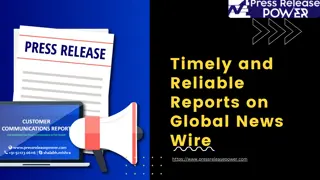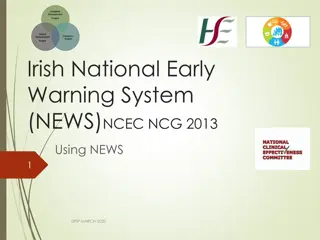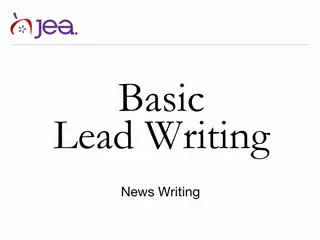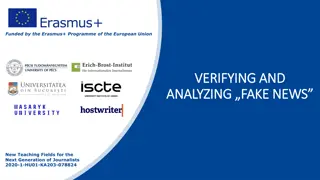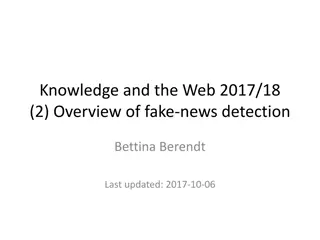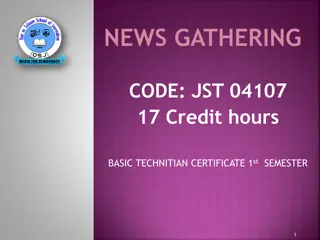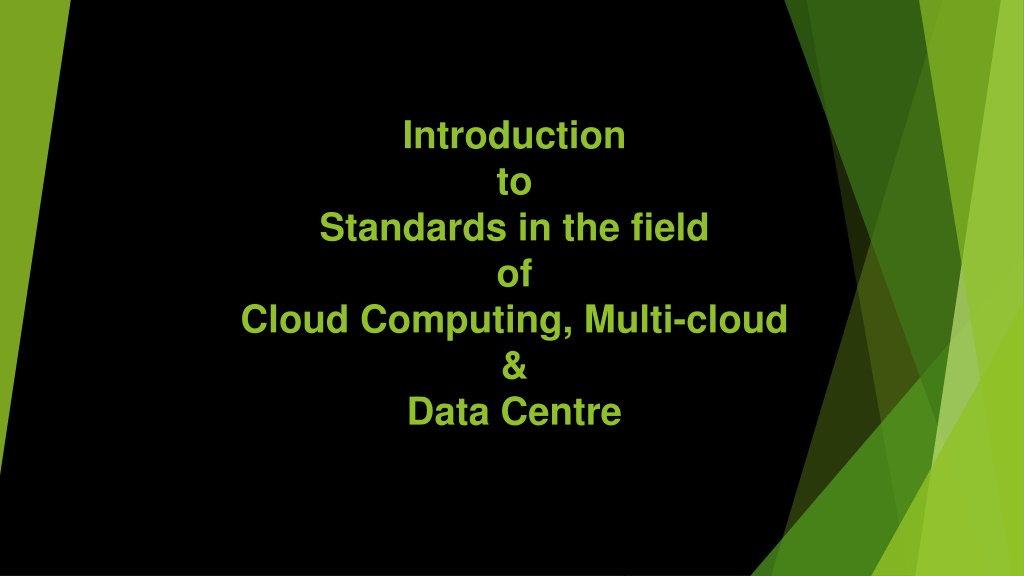
Cloud Computing Standards and Benefits Explained
Explore the field of cloud computing, multi-cloud, and data centers including concepts, syllabus topics, benefits of standards, and examples of successful cloud adoption by organizations like Netflix and Airbnb. Discover the importance of standards, government support, industry benefits, and the role of cloud computing in driving business growth and operational efficiency.
Download Presentation

Please find below an Image/Link to download the presentation.
The content on the website is provided AS IS for your information and personal use only. It may not be sold, licensed, or shared on other websites without obtaining consent from the author. If you encounter any issues during the download, it is possible that the publisher has removed the file from their server.
You are allowed to download the files provided on this website for personal or commercial use, subject to the condition that they are used lawfully. All files are the property of their respective owners.
The content on the website is provided AS IS for your information and personal use only. It may not be sold, licensed, or shared on other websites without obtaining consent from the author.
E N D
Presentation Transcript
Introduction to Standards in the field of Cloud Computing, Multi-cloud & Data Centre
Topics generally covered in the Syllabus Concepts of Cloud Computing Current Trends in information Security - Cloud Computing Cloud Computing Principles Basics of Cloud Infrastructure Common Technologies and Techniques in Cloud Computing Architecture, models of cloud services (IaaS, PaaS, SaaS) Virtualization Virtual Machines, Hypervisors, Data Centre Concepts Data Centre Facilities and Infrastructures Performance of Data Centre Key performance indicators
Benefits of Standards Government/Regulator Support Government policies and legislations Technical references in public tenders Promote access to global trade For Industry Define quality, safety & health and protect environment Facilitate interoperability Enhance quality efficiency Assessment demonstration conformity of quality Efficiently make technical information Disseminate management and business practices For Consumer & raise level of Provide consumer choice of certified products & services Products with improved quality and reliability at competitive prices Safer, healthier, more environmentally sound products and services Better operational compatibility greater consistency in delivery and and available good
Concepts of Cloud Computing Components of cloud Cloud Data storage, servers, databases, networking, internet and software Definition:Paradigm for enabling network access to a scalable and elastic pool of shareable physical or virtual resources with self-service provisioning and administration on-demand. Cloud Computing (reference clause 3.2.5 of IS/ISO/IEC 17788)
Benefits of cloud computing and Data Centres Cloud computing provide organization to successfully adopt and leverage cloud technologies to drive business growth, optimize costs, and improve operational efficiency. Examples: Netflix:Leading online streaming service, relies on the Amazon Web Services (AWS) cloud infrastructure to support its massive scale and global reach. Airbnb/booking.com: Popular online marketplace for lodging, primarily uses cloud services to host their applications and manage its massive amounts of data. By leveraging cloud services, have grown rapidly, streamlined its operations, and developed innovative features to enhance user experience and satisfaction. Coca-Cola/Shell/General Electric: By leveraging Google s cloud services, these companies have enhanced its global data analytics capabilities, improved its supply chain efficiency, and delivered personalized experiences to its customers.
Taxonomy Based Data Handling for Cloud Services Overview Data polices and practices, at corporate and government level, needs to be crispy expressed with desired degree of precision and clarity. It requires, Framework for structured expression of data related policies and practices; Guidance for using the framework; Use of framework in specific areas of concern; Application of framework to code of conduct. IS/ISO/IEC 22624 : 2020, Cloud Computing Taxonomy Based Data Handling for Cloud Services
Important Definitions Cloud service (clause 3.2.8): One or more capabilities offered via cloud computing invoked using a defined interface. Cloud service customer (clause 3.2.11): Party which is in a business relationship for the purpose of using cloud services. Cloud service provider (clause 3.2.15): Party which makes cloud services available. Private cloud (clause 3.2.32):Cloud deployment model where cloud services are used exclusively by a single cloud service customer and resources are controlled by that cloud service customer. Public cloud (clause 3.2.33) : Cloud deployment model where cloud services are potentially available to any cloud service customer and resources are controlled by the cloud service provider. Community cloud (clause 3.2.19): Cloud deployment model where cloud services exclusively support and are shared by a specific collection of cloud service customers who have shared requirements and a relationship with one another, and where resources are controlled by at least one member of this collection. Service level agreement (SLA) (clause 3.1.7): Documented agreement between the service provider and customer that identifies services and service targets. IS/ISO/IEC 17788: 2014, Cloud Computing Overview and Vocabulary
Key characteristics of cloud computing Broad network access Resource pooling Key characteristics of cloud computing (clause 6.2) Rapid elasticity and scalability Measured service On-demand self- service Multi-tenancy IS/ISO/IEC 17788: 2014, Cloud Computing Overview and Vocabulary
Cloud deployment models Community cloud Private cloud Cloud deployment models (clause 6.5) Public cloud Hybrid cloud IS/ISO/IEC 17788: 2014, Cloud Computing Overview and Vocabulary
Private cloud services are maintained on a private network and are used exclusively by one organization. Unlike public clouds, private clouds are not shared with other organizations. Examples: VMware: Provides virtualization software and services for building private clouds. Private Cloud (clause 6.5) Public cloud services are delivered over the public internet and shared across multiple organizations, providing scalable and flexible computing resources on a pay-as-you-go basis. Public Cloud (clause 6.5) Examples: AWS, Google Cloud Platform (GCP), Microsoft Azure Hybrid cloud combines public and private cloud environments, allowing data and applications to be shared between them. This integration provides flexibility and optimization of IT resources based on specific business needs. Examples: VMware Cloud Foundation: Integrates private cloud infrastructure with public cloud services from AWS, Azure, and Google Cloud. Hybrid Cloud (clause 6.5) A community cloud is a shared infrastructure that serves several organizations with similar requirements, such as specific security, compliance, or regulatory needs. It may be managed internally by the organizations or by a third-party provider. Examples: Government Community Cloud: Used by government agencies to share resources and data securely while meeting regulatory requirements. Healthcare Community Cloud: Shared by healthcare organizations to store and manage patient data securely, ensuring compliance with healthcare regulations like HIPAA. Community Cloud (clause 6.5)
Primary Models of Cloud Computing Infrastructure as a Service (IaaS) (clause 3.2.24): Cloud service category in which the cloud capabilities type provided to the cloud service customer is an infrastructure capabilities type. Examples: Amazon Web Services (AWS), Microsoft Azure, Google Cloud Platform (GCP). Platform as a Service (PaaS) (clause 3.2.30): A cloud service category in which the cloud capabilities type provided to the cloud service customer is a platform capabilities type Examples: Heroku: A cloud platform that enables developers to build, run, and operate applications entirely in the cloud. Microsoft Azure App Services: A cloud platform for building, deploying, and scaling web apps and APIs. IS/ISO/IEC 22624 : 2020 - Primary Models of Cloud Computing
Primary Models of Cloud Computing Software as a Service (SaaS) (clause 3.2.36): Cloud service category in which the cloud capabilities type provided to the cloud service customer is an application capabilities type. Examples: Google Workspace: A suite of cloud-based productivity and collaboration tools including Gmail, Docs, Drive, and Calendar. Microsoft 365:A collection of cloud services including Word, Excel, PowerPoint, and Outlook, along with collaboration tools like Teams and OneDrive. Salesforce:A cloud-based customer relationship management (CRM) platform that provides various tools for sales, service, marketing, and analytics. IS/ISO/IEC 22624 : 2020 - Primary Models of Cloud Computing
Comparison in terms of who manage what IaaS PaaS SaaS Data & Configurations Data & Data & Configurations Configurations Application code Application code Application code Managed by CSC Scaling Scaling Scaling Managed by CSP Run Time Run Time Run Time OS OS OS Virtualization Virtualization Virtualization Hardware Hardware Hardware
Common Technologies and Techniques used in Cloud Computing Infrastructure capabilities type of cloud services which includes: virtual machines, containers, virtualized storage, virtualized networking and security. Platform capabilities type of cloud services which includes: containers, server less computing, virtualized storage, virtualized networking, security. Software application capabilities type of cloud services which includes: virtualized storage, virtualized networking, and security. IS/ISO/IEC TS 23167 : 2020 (clause 5.2)
Virtual machines and Hypervisors Virtual machines (VM) and hypervisors are technologies that provide virtualized processing (also known as virtualized compute) for cloud services. The hypervisor, termed a virtual machine monitor, is software that virtualizes physical resources and allows for running virtual machines. Virtualization means control of the abstraction of the underlying physical resources of the system. The hypervisor also manages the operation of the VMs. The hypervisor allocates resources to each running VM including processor (CPU), memory, disk storage and networking capabilities and bandwidth. (Refer IS/ISO/IEC TS 23167 : 2020) (clause 6)
Types of Hypervisors Type of Hypervisor 1. Bare metal", "native" or "type I"; 2. Embedded", "hosted" or "type II". IS/ISO/IEC TS 23167 : 2020 (clause 6.3.1)
Common Technologies and Techniques used in Cloud Computing Bare metal", "native" or Type I Embedded", "hosted" or Type II
Cloud Computing Guidance for Policy Development Formulation of government/enterprises policies Aspects for Policy Makers Cloud computing essential characteristics (clause 6.2) Major benefits of cloud computing (clause 6.3) Implications for policy makers (clause 6.4) Using international standards to assist in developing policies that cover cloud Computing (clause 7) Considerations of regulatory, advisory and procurement policy when developing policy (clause 8) IS/ISO/IEC TR 22678 : 2020), Cloud Computing Guidance for Policy Development
Cloud Computing Edge Computing Landscape Concepts of edge computing Edge computing is distributed computing in which data processing and storage takes place on nodes which are near to the edge. Edge computing is characterized by networked systems in which significant data processing and storage takes place on nodes near the edge, rather than in some centralized location. Edge computing can be contrasted with centralized computing where the centralized nodes are remote from the edge. (Reference clause 5.2 of IS/ISO/IEC TR 23188 : 2020) Architectural foundations of edge computing Edge computing involves nodes that are highly heterogeneous and which are commonly arranged in tiers of compute and storage capabilities. A simplified view of the organization of edge computing nodes and the networks connecting them in edge computing is shown in Figure. Reference clause 5.3 of IS/ISO/IEC TR 23188 : 2020
Edge Computing Landscape Organization of nodes in edge computing Edge computing involves nodes that are highly heterogeneous and which are commonly arranged in the tiers of compute and storage capabilities. A simplified view of the organization of edge computing nodes and network connecting them in edge computing is given in the figure below: IS/ISO/IEC TR 23188 : 2020, Cloud Computing Edge Computing Landscape
Cloud Service Metering Elements and Billing Modes Basically there are three Cloud service metering elements covered in the standard: Cloud service metering elements for 1. Infrastructure capabilities type (clause 6.1) include processing resources, storage resources and networking resources 2. Platform capabilities type (clause 6,2) include message oriented middleware, catche size, instant running time, database (like processing requests, memory size etc) 3.Application capabilities type (clause 6.3) include API usage, application software (such as application count, running time) IS/ISO/IEC TR 23613 : 2020- Cloud Service Metering Elements and Billing Modes
Cloud Computing Service Level Agreement (SLA) Framework A Service Level Agreement (SLA) is the bond for performance negotiated between the cloud services provider and the client. Earlier, in cloud computing all Service Level Agreements were negotiated between a client and the service consumer. Now a days, with the initiation of large utility-like cloud computing providers, most Service Level Agreements are standardized.
Cloud Computing Service Level Agreement (SLA) Framework Series of Indian Standards on SLA: 1. IS/ISO/IEC 19086-1 : 2016 Service Level Agreement (SLA) Framework - Part 1 - Overview and Concepts 2. IS/ISO/IEC 19086-2 : 2018 Service Level Agreement (SLA) Framework - Part 2 - Metric Model 3. IS/ISO/IEC 19086-3 : 2017 Service Level Agreement ( SLA ) Framework - Part 3 - Core Conformance Requirements 4. IS/ISO/IEC 19086-4 : 2019 Service Level Agreement ( SLA ) Framework - Part 4 - Components of Security and of Protection of PII
Service Level Agreement ( SLA ) Framework - Overview and Concepts Fundamental concepts of the cloud SLA framework: 1. Cloud Service Agreement (CSA) 2. Cloud Service Level Agreement (SLA) 3. Cloud Service Level Objectives (SLO) 4. Cloud Service Qualitative Objectives (SQO) IS/ISO/IEC 19086-1 : 2010 CLOUD COMPUTING SERVICE LEVEL AGREEMENT ( SLA ) FRAMEWORK- PART 1 OVERVIEW AND CONCEPT
Service Level Agreement ( SLA ) Framework - Metric Model Metric Standard of measurement (key performance indicator) that defines the conditions and rules for performing the measurement and for understanding the measurement result. IS/ISO/IEC 19086-2 : 2018CLOUD COMPUTING SERVICE LEVEL AGREEMENT ( SLA ) FRAMEWORK - PART 2 - METRIC MODEL
Service Level Agreement ( SLA ) Framework - Core Conformance Requirements Components for defining core requirements 1. Cloud response time 2. Protection of personally identified information (PPI) content area 3. Information security content area 4. Governance (government) component 5. Changes to the cloud service features and functionality 6. Service reliability 7. Disaster recovery component 8. Intellectual property rights (IPR) component 9. Cloud service customer data IS/ISO/IEC 19086-3 : 2017, Cloud Computing Service Level Agreement (SLA) Framework - Part 3 Core Conformance Requirements
Service Level Agreement ( SLA ) Framework - Components of Security and of Protection of PII Components of Information Security System 1. Information security policy 2. Asset management component 3. Access control component 4. Cryptography component 5. Physical and environmental security component 6. Operations security component 7. Communications security component 8. Systems acquisition, development and maintenance component 9. Supplier relationships component 10.Information security incident management IS/ISO/IEC 19086-4 : 2019 , Cloud Computing Service Level Agreement ( SLA ) Framework - Part 4 - Components of Security and of Protection of PII
Multi-cloud Multi-cloud refers to a cloud computing strategy where organizations use services and resources from multiple cloud providers. This approach allows them to distribute workloads across different cloud environments, optimizing performance, enhancing resilience, avoiding vendor lock-in, and meeting specific business and regulatory requirements effectively. Examples Company A: uses Amazon Web Services (AWS) for its data storage and Microsoft Azure for its machine learning and AI services. By adopting a multi-cloud strategy, Company A can leverage AWS's robust storage capabilities while benefiting from Azure's advanced AI tools.
Models of Multi-Cloud 1 Multi-Cloud In a multi-cloud CDM, the CSC is responsible for providing cloud service administrator and business manager functions for a defined set of cloud service users (CSUs).. 2. Federated cloud A federated cloud is a CDM in which cloud services are provided by two or more members of a cloud service federation (CSF). 3. Hybrid cloud A hybrid cloud is a CDM that uses both a public cloud and a private cloud. The public and private clouds involved remain unique but are bound together by appropriate technology that enables interoperability, data portability and application portability. ISO/IEC 5140:2024 Cloud computing Concepts for multi-cloud and the use of multiple cloud services
Data Centers Data centers provide critical infrastructure for the storage, management, and dissemination of data and are essential for business operations in various industries. A data center in cloud computing is the physical foundation. Data centers are the powerhouses behind cloud computing and provide the essential infrastructure that allows cloud providers to offer services like storage, compute power, and databases on-demand. There are 14 Indian standards published or under development on Data Centres
Data Centre vs. The Cloud Point of Difference Data Centre Cloud Computing A physical facility for storing, managing, and processing data A virtualized service that provides on-demand access to computing resources Definition Owned and managed by the organization itself Owned and managed generally by a third-party provider Ownership Dedicated software hardware and Infrastructure Shared hardware and software Limited by physical capacity and upgrades Highly scalable, can quickly add or remove resources Scalability Limited by physical location and connectivity Accessible from anywhere with an internet connection Availability Typically provides physical and network security The provider manages security measures Security High initial capital investment and ongoing maintenance Pay-as-you-go model; more cost- effective for small businesses and startups Cost Highly customizable to meet specific needs Limited customization options for off the shelf services Customization
Data Centre Facilities and Infrastructures Classification for Design of Data Centre 1. Availability (Single site / Multi-site) 2. Physical Security 3. Energy Efficiency enablement- Classification by Design IS/ISO/IEC 22237-1: 2021, Data Centre Facilities and Infrastructures - Part 1: General Concepts
Data Centre Facilities and Infrastructures : Building construction Requirement for building constructions of Data Centre a) Location and site selection (taking in to account natural environment and adjacencies); b) Protection from environmental risks; c) Site configuration; d) Building construction; e) Building configuration; f) Provision of access; g) Physical intrusion protection; h) Physical fire protection; i) Protection against damage from water; j) Quality construction measures. ISO/IEC 22237-2 : 2024 - Data Centre Facilities and Infrastructures : Building construction Please use the following link to access standard ISO/IEC 22237-1: 2021 https://www.iso.org/standard/82248.html
Typical functional elements of power supply and distribution Area Functional element Typical accommodation Supply Primary supply/ Secondary Supply Supply (where multiple supply exists) Transformer space transfer equipment Electrical space Addition supply (Generator/UPS) Generator space/ Electrical space Electrical distribution space Transformer space Distribution Primary distribution equipment UPS Electrical space (or computer room space) Electrical space Transformer space (if required) Secondary equipment distribution Tertiary distribution equipment Computer spaces requiring provisions of protected supplies room spaces or IS/ISO/IEC 22237-3: 2021-Data Centre Facilities and Infrastructures : Power Distribution
Data Centre Facilities and Infrastructures : Environmental Control This standard addresses environmental control within data centres based upon the criteria and classifications for availability , security and energy efficiency enablement within IS/ISO/IEC 22237-1. This standard specifies requirements and recommendations for the following: a) temperature control; b) fluid movement control; c) relative humidity control; d) particulate control; e) vibration; f) physical security of environmental control systems. IS/ISO/IEC 22237-4: 2021, Data Centre Facilities and Infrastructures : Environmental Control
Data Centre Facilities and Infrastructures : Telecommunications cabling infrastructure This standard addresses the wide range of telecommunications cabling infrastructures within data centres based upon the criteria and classifications for availability within IS/ISO/IEC TS 22237-1. This standard specifies requirements and recommendations for the following: a) information technology and network telecommunications cabling (e.g. SAN and LAN); b) general information technology cabling to support the operation of the data centre; c) telecommunications cabling to monitor and control, as appropriate, power distribution, environmental control and physical security of the data centre; d) other building automation cabling; e) pathways, spaces and enclosures for the telecommunications cabling infrastructures. ISO/IEC 22237-5 : 2018, Data Centre Facilities and Infrastructures : Telecommunications cabling infrastructure
Data Centre Facilities and Infrastructures : Security systems This standard specifies requirements and recommendations concerning the physical security of data centres based on the criteria and classifications for availability , security and energy efficiency enablement within IS/ISO/IEC 22237-1. This standard provides designations for the data centre spaces defined in IS/ISO/IEC 22237-1. This standard specifies requirements and recommendations for such data centre spaces, and the systems employed within those spaces, in relation to protection against: a) unauthorized access addressing organizational and technological solutions; b) intrusion; c) internal fire events igniting within data centre spaces; d) internal environmental events (other than fire) within the data centre spaces which would affect the defined level of protection; e) external environmental events outside the data centre spaces which would affect the defined level of protection. ISO/IEC 22237-6:2024, Data Centre Facilities and Infrastructures : Security systems
Performance of Data Centre Series of standards on Key Performance Indicators (KPI) of Data Center 1. IS/ISO/IEC 30134 - 1 : Part 1 Overview and General Requirements 2. IS/ISO/IEC 30134 - 2 : Part 2 Power Usage Effectiveness ( PUE ) 3. IS/ISO/IEC 30134 - 3 : Part 3 Renewable Energy Factor ( REF ) 4. IS/ISO/IEC 30134 - 4 : Part 4 Equipment Energy Efficiency for Servers (ITEEsv ) 5. IS/ISO/IEC 30134 - 5 : Part 5 IT Equipment Utilization for Servers (ITEUsv ) 6. IS/ISO/IEC 30134 - 6 : Part 6 Energy Reuse Factor ERF 7. IS/ISO/IEC 30134 - 8 : Part 8 Carbon Usage Effectiveness CUE 8. IS/ISO/IEC 30134 - 9 : Part 9 Water Usage Effectiveness WUE
Data Centers Key Performance Indicators Common Objectives the minimization of energy and other resource (e.g. water) consumption; the task effectiveness of the IT load (data processing, storage and transport) within the data centre, maximizing the IT output with the minimum energy consumption; the energy reuse in the form of waste heat, if possible; the use of renewable energy, both generated on site and off site. IS/ISO/IEC 30134-1:2016 , Data Centers Key Performance Indicators - Part 1 Overview and General Requirements
Data Centers Key Performance Indicators - Power Usage Effectiveness (PUE) Power Usage Effectiveness (PUE) ratio of the data centre total energy consumption to information technology equipment energy consumption, calculated, measured or assessed across the same period IS/ISO/IEC 30134-2 : 2016, Data Centers Key Performance Indicators - Power Usage Effectiveness (PUE)
Data Centers Key Performance Indicators - Renewable Energy Factor (REF) Renewable Energy Factor (REF) ratio of the renewable energy (3.1.1) owned and controlled by a data centre to the total data centre energy consumption IS/ISO/IEC 30134-3 : 2016, Data Centers Key Performance Indicators - Renewable Energy Factor (REF)
Data Centers Key Performance Indicators - IT Equipment Energy Efficiency for Servers (ITEEsv) Information Technology Equipment Energy Efficiency for servers (ITEEsv) maximum performance per kW of all servers or a group of servers in a data centre IS/ISO/IEC 30134-4 : 2017, Data Centers Key Performance Indicators - IT Equipment Energy Efficiency for Servers (ITEEsv)
Data Centers Key Performance Indicators - IT Equipment Utilization for Servers (ITEUsv) IT Equipment Utilization for Servers (ITEUsv) average utilization ratio of all servers or a group of servers in a data centre IS/ISO/IEC 30134-5 : 2017, Data Centers Key Performance Indicators - IT Equipment Utilization for Servers (ITEUsv)
Data Centers Key Performance Indicators - Energy Reuse Factor (ERF) Energy Reuse Factor (ERF) is defined as the ratio of energy being reused divided by the sum of all energy consumed in a data centre. The ERF does reflect the efficiency of the reuse process; the reuse process is not part of a data centre. IS/ISO/IEC 30134-6 : 2021, Data Centers Key Performance Indicators - Energy Reuse Factor ERF
Data Centers Key Performance Indicators - Carbon Usage Effectiveness (CUE) Carbon Usage Effectiveness (CUE) ratio of the data centre annual CO2 emissions and IT equipment energy demand IS/ISO/IEC 30134-8 : 2022, Data Centers Key Performance Indicators - Carbon Usage Effectiveness CUE
Data Centers Key Performance Indicators - Water Usage Effectiveness (WUE) Water Usage Effectiveness (WUE) ratio of the data centre water consumption divided by the energy consumed by IT equipment IS/ISO/IEC 30134-9 : 2022, Data Centers Key Performance Indicators: Water Usage Effectiveness (WUE)
Indian Standards in the field of Cloud Computing, Multi-cloud & Data Centre



